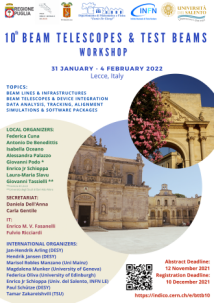Conveners
Facilities: Test beam
- Alexander Gerbershagen (CERN)
Facilities: Irradiation
- Paul Schütze (Deutsches Elektronen-Synchrotron (DE))
The CERN beam lines of the North and the East Area are designed to deliver beams of secondary and tertiary particles as well as attenuated primary protons and ions from the SPS and PS accelerators. Typically, hadrons, electrons, and muons in the energy range up to 360 GeV/c at a maximum flux of 10^7 - 10^8 particles per SPS extraction are served to the experimental areas. Following the Long...
The DESY II Test Beam Facility was in operation from March to December in 2021, starting with local and national users before continuing from May on in normal mode welcoming international groups. After the winter shutdown, the facility resumed operation in February 2022.
In this contribution, a review over the test beam period in 2021 and the current status is given. This includes first...
The Fermilab Test Beam Facility is a world class facility for testing and characterizing particle detectors. With two operational low intensity beam lines, the facility can deliver a variety of particle types and momenta ranging from 120 GeV protons in the primary beam line down to 200 MeV particles in the tertiary beam line. In order to meet the needs of future detectors, the facility is...
An Irradiation Test Area(ITA) has been operating at Fermilab since 2021 with a beam delivering 400 MeV protons at an intensity up to 2.7e15 protons per hour. This talk will cover lessons learned and present status of the facility, user application process, and future upgrade plans.
The upcoming High-Luminosity upgrade of the CERN Large Hadron Collider (HL-LHC) and the R&D on future accelerators (FCC) require radiation hardness tests and detector qualifications. The reference facilities at CERN for muon gas detectors is the GIF++, located on the H4 beam-line in the SPS North Area.
The last years were dominated by the mass production tests for the ATLAS Phase 1 upgrade,...
The CERN Proton Irradiation Facility (IRRAD) is a reference facility for performing irradiation experiments and qualification of tracking and calorimetry detectors, important for the upgrade of CERN Large Hadron Collider (HL-LHC) and for the R&D on future CERN accelerators. After the CERN Long Shutdown 2, the IRRAD facility has undergone through several changes on hardware and software...
